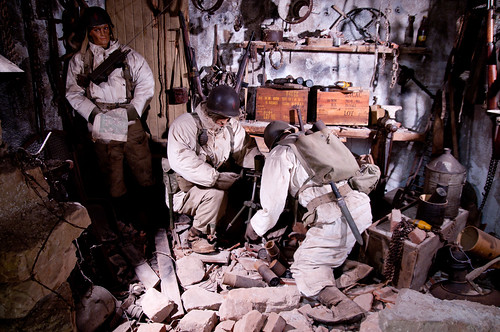The Battle of the Bulge was undoubtedly one of the big surprises of the Second World War was also one of the most famous battles of the war, after perhaps the most famous of all, the battle of Normandy. Large numbers come with it: three huge armies clashed, the U.S. and Britain by the Allies (totaling 840,000 soldiers and 1,300 tanks), and Germany on the Axis (with a force of about 500,000 men. And more than 1,800 armored). About 90,000 soldiers were killed by each side (and 3,000 civilians), and after months of struggling, the battle was a draw. Only it was the last major battle launched by the Germans, who were finally exhausted and the dying remnants of an army that it could neither defend the borders of their country.

Photography by Jeff Kubina
Tourist route:
The Battle of the Bulge took place between December 16, 1944 and January 28, 1945, in a relatively narrow area of Belgium. Their field of battle, the area between the cities of Liege and Luxembourg, and its front line more or less follows the path of the current E25.
If today we move through the country roads of this beautiful eastern region of Wallonia, it is certain that at each crossing we find a monument to the battle, tank, artillery piece or memorial celebrations. Also, several cemeteries of the time. In a few days we can go calmly throughout this region of Belgium and visit among other attractions, a host of museums and commemorative items from one of the most dramatic passages in the history of Europe. Belgium is one of those few countries that has preserved perfectly historical memory, with respect but also openly showing the hechosde that time.
Here are some of the most important attractions of this tourist route by which war was the Battle of the Bulge. Today we will focus on museums, monuments and points of interest varied in the next installment.
Museum of the Battle of the Bulge:
There are a number of museums dedicated to the battle, then we list the main ones. In July and August are usually open every day, even at midday.
Bastogne Historical Centre:
Opened in 1976 by Prince Albert who later became King Albert II of Belgium, the museum (built in star-shaped clear nod to the U.S. Army) presents an outstanding collection of uniforms and arms of the troops on both sides who fought in the Battle for Bastogne. It also has a cinema which displays stories filmed in the race for American and German cameras. The museum is open between February and November, and is an excellent place to start our visit and get familiar with the facts.

Photography by archangel 12
Museum in December 1944:
This museum covers the history of Kampfgruppe Pieper and the battle for the town of Gleize. It was here that the famous German armored squadron was arrested. There are original King Tiger tank in the vicinity exposed quite spectacular, rare and hard to find specimen of this model of American tank. The story of this confrontation is excellently explained through 15 dioramas in which are mounted the main scenes. We also have hundreds of photographs and videos with the details. The museum is open from March to November, 10 to 18 hours.
Museum of the Battle of the Bulge:
This museum focuses in particular on the role of British troops in battle, much more discreet than the American, but no less important. Near La Roche-en-Ardenne, in Hotton, we can approach the Commonwealth’s military museum, where 325 British soldiers lie buried.
To highlight the ‘Hall of machine guns’, which displays 90 rifles, pistols and revolvers of various armies, and one of the famous original Enigma machines from Poland.
Spitfire Memorial Museum:
Located at an airfield, the museum displays a Spitfire MK XIV of 1944 original, as well as various types of aircraft in the history of aviation in Belgium. It also tells the story of the airfield and the squadrons that were based here, through documents and graphics models. The museum is closed Saturdays, Sundays and Mondays.
Baugnez 44 Historical Center:
This museum was opened a few years ago and is dedicated to the slaughter of Malmedy where 84 American soldiers were disarmed and executed in cold blood by the Nazi army. We have a guided tour in German, French, English and Dutch, and the visit lasts an hour and a half. During the tour, the guide informed us of the context and details of this tragic story. We also explain much of the Battle of the Bulge as a whole.
Then we watch a movie about 25 minutes (in the same language) with explanation. The tour costs 7.5 euros per adult and 6 child (8 to 12 years). Children this age will have to pay 2 euros for guidance.
We have left many things to see on the road. As I said before, this region of Belgium is full of monuments, memorials, cemeteries and tanks exposed everywhere. A lesson in modern history that we should not miss the opportunity to study, even tourist-minded and superficial. In a second installment will discuss some of these other points of interest more striking.

Photography by paul-simpson.org
And you would you interested in tourism and visiting sites representing war as the Ardennes region?
Leave a Reply
You must be logged in to post a comment.
Recent Comments